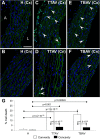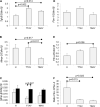Experimental evidence of the genetic hypothesis on the etiology of bicuspid aortic valve aortopathy in the hamster model
- PMID: 36003906
- PMCID: PMC9393263
- DOI: 10.3389/fcvm.2022.928362
Experimental evidence of the genetic hypothesis on the etiology of bicuspid aortic valve aortopathy in the hamster model
Abstract
Bicuspid aortopathy occurs in approximately 50% of patients with bicuspid aortic valve (BAV), the most prevalent congenital cardiac malformation. Although different molecular players and etiological factors (genetic and hemodynamic) have been suggested to be involved in aortopathy predisposition and progression, clear etiophysiopathological mechanisms of disease are still missing. The isogenic (genetically uniform) hamster (T) strain shows 40% incidence of BAV, but aortic dilatations have not been detected in this model. We have performed comparative anatomical, histological and molecular analyses of the ascending aorta of animals with tricuspid aortic valve (TAV) and BAV from the T strain (TTAV and TBAV, respectively) and with TAV from a control strain (HTAV). Aortic diameter, smooth muscle apoptosis, elastic waviness, and Tgf-β and Fbn-2 expression were significantly increased in T strain animals, regardless of the valve morphology. Strain and aortic valve morphology did not affect Mmp-9 expression, whereas Mmp-2 transcripts were reduced in BAV animals. eNOS protein amount decreased in both TBAV and TTAV compared to HTAV animals. Thus, histomorphological and molecular alterations of the ascending aorta appear in a genetically uniform spontaneous hamster model irrespective of the aortic valve morphology. This is a direct experimental evidence supporting the genetic association between BAV and aortic dilatation. This model may represent a population of patients with predisposition to BAV aortopathy, in which increased expression of Tgf-β and Fbn-2 alters elastic lamellae structure and induces cell apoptosis mediated by eNOS. Patients either with TAV or BAV with the same genetic defect may show the same risk to develop bicuspid aortopathy.
Keywords: animal model; aortic dilatation; bicuspid aortic valve (BAV); etiology; hamster; pathophysiology.
Copyright © 2022 Soto-Navarrete, Pozo-Vilumbrales, López-Unzu, Rueda-Martínez, Fernández, Durán, Pavón-Morón, Rodríguez-Capitán and Fernández.
Conflict of interest statement
The authors declare that the research was conducted in the absence of any commercial or financial relationships that could be construed as a potential conflict of interest.
Figures





Similar articles
-
Unraveling the molecular complexity of bicuspid aortopathy: Lessons from comparative proteomics.Biochim Biophys Acta Mol Basis Dis. 2025 Mar;1871(3):167679. doi: 10.1016/j.bbadis.2025.167679. Epub 2025 Jan 18. Biochim Biophys Acta Mol Basis Dis. 2025. PMID: 39832690
-
Aortopathy and regurgitation in bicuspid valve patients increase the risk of aortopathy in relatives.Int J Cardiol. 2019 Jul 1;286:117-120. doi: 10.1016/j.ijcard.2019.03.031. Epub 2019 Mar 18. Int J Cardiol. 2019. PMID: 30954286
-
The role of hemodynamics in bicuspid aortopathy: a histopathologic study.Cardiovasc Pathol. 2019 Jul-Aug;41:29-37. doi: 10.1016/j.carpath.2019.03.002. Epub 2019 Apr 1. Cardiovasc Pathol. 2019. PMID: 31029755
-
Enlightening the Association between Bicuspid Aortic Valve and Aortopathy.J Cardiovasc Dev Dis. 2018 Apr 19;5(2):21. doi: 10.3390/jcdd5020021. J Cardiovasc Dev Dis. 2018. PMID: 29671812 Free PMC article. Review.
-
[BICUSPID AORTIC VALVE AND LEFT VENTRICULAR OUTFLOW TRACT DEFECTS IN CIIILDREN - SYNDROME OF BICUSPID AORTOPATHY?].Lijec Vjesn. 2015 Sep-Oct;137(9-10):267-75. Lijec Vjesn. 2015. PMID: 26749948 Review. Croatian.
Cited by
-
Endocardial-to-mesenchymal transition underlies cardiac outflow tract septation and bicuspid aortic valve formation in the Syrian hamster model.Sci Rep. 2025 Mar 12;15(1):8583. doi: 10.1038/s41598-025-91454-6. Sci Rep. 2025. PMID: 40074779 Free PMC article.
-
Genetic models of fibrillinopathies.Genetics. 2024 Jan 3;226(1):iyad189. doi: 10.1093/genetics/iyad189. Genetics. 2024. PMID: 37972149 Free PMC article. Review.
-
Circulating Matrix Metalloproteinases for Prediction of Aortic Dilatation in Children with Bicuspid Aortic Valve: A Single-Center, Observational Study.Int J Mol Sci. 2024 Sep 30;25(19):10538. doi: 10.3390/ijms251910538. Int J Mol Sci. 2024. PMID: 39408865 Free PMC article.
-
Smooth muscle cell phenotypic switching occurs independent of aortic dilation in bicuspid aortic valve-associated ascending aortas.PLoS One. 2024 Jul 2;19(7):e0306515. doi: 10.1371/journal.pone.0306515. eCollection 2024. PLoS One. 2024. PMID: 38954721 Free PMC article.
References
-
- Michelena HI, Della Corte A, Evangelista A, Maleszewski JJ, Edwards WD, Roman MJ, et al. International consensus statement on nomenclature and classification of the congenital bicuspid aortic valve and its aortopathy, for clinical, surgical, interventional and research purposes. Eur J Cardiothorac Surg. (2021) 60:448–76. 10.1093/ejcts/ezab038 - DOI - PubMed
LinkOut - more resources
Full Text Sources
Miscellaneous

